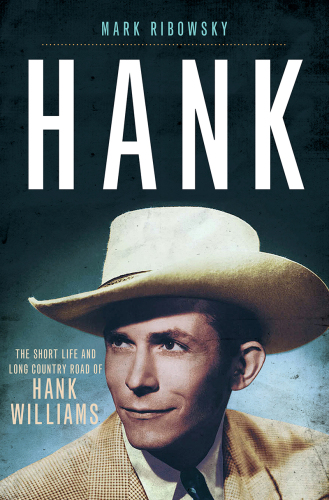
Hank
The Short Life and Long Country Road of Hank Williams
کتاب های مرتبط
- اطلاعات
- نقد و بررسی
- دیدگاه کاربران
نقد و بررسی

December 5, 2016
Country singer Hank Williams’s story is already so well known that Ribowsky’s (Dreams to Remember) entertaining, critical biography reveals no newly uncovered information about him. Nevertheless, Ribowsky is an engaging storyteller, and he tells Williams’ story with such verve and humor—albeit with some over-the-top phrasing (“he was a dysfunction junction”; “Hank seemed like an afterthought lying carefree in a casket”)—that Williams and his music come alive. He chronicles Williams’s childhood in Alabama; his marriage
to Audrey Mae Sheppard Guy, and their miserable but symbiotic relationship; his slow but sure rise to country music stardom on the Grand Ole Opry and WSM radio; his marriage to Billie Jean Eshliman; and his death in the back of his Cadillac on January 1, 1953, at the age of 29. Ribowsky offers cunning readings of Williams’s songs: “Mansion on the Hill,” he says, reflects a familiar Williams template that is “part croon, part hoedown, and a metaphoric lament of loneliness and the promise of a reward too far.” Williams emerges from Ribowsky’s powerful biography not only as the author of many familiar country and pop favorites, such as “Hey, Good Lookin’ ” and “Your Cheatin’ Heart,” but also as a man whose back pain drove him to drink and pills and whose soul was filled more often with gloom than with light.

September 15, 2016
"Everything he did was bad for his health": a sturdy biography of the unsteady icon of outlaw country avant la lettre.Luke the Drifter. The Hillbilly Shakespeare. Before Elvis came along, the King. Hiram King Williams (1923-1953) bore many names and monikers, as befits someone constantly on the move. When he became famous as a musician, being on the move was a requirement; Williams had to get from one gig to another, no matter how drunk or drugged he might be when he took the stage. But even early on, writes Florida-based music journalist Ribowsky (Sweet Dreams and Flying Machines: The Life and Music of James Taylor, 2016, etc.), Williams was used to life on the go, his father often traveling on his railroad job, sometimes a step away from the poorhouse. Born with a spinal defect, Williams channeled his pain into music but then, once the music was on paper or acetate, tried to move that pain farther along with an appalling diet of morphine, pharmaceuticals, and booze, all of which hastened his death. As Ribowsky notes, several templates were thus established, from death by prescription-happy doctor (Elvis, Michael Jackson) to country star as soused or pilled-up rebel (Johnny Cash, George Jones). The author is very good on the culture that surrounded Williams, enshrined by an Alabaman who told him, "you do what you gotta do on Saturday night, then go to church on Sunday morning and make it all right with God." Though defiantly separatist, that culture, in Williams' case, was laced with the blues and gospel as much as mountain music. Ribowsky covers the details of Williams' untidy personal life without undue sensationalism, and if it lacks the intellectual depth of a Greil Marcus or the lived-in encyclopedism of a Peter Guralnick, his book is just fine for what it is, a decidedly warts-and-all portrait of a man more revered than listened to these days. It's not every 29-year-old who can pack enough into a life to warrant a 500-page biography--and a good one at that.
COPYRIGHT(2016) Kirkus Reviews, ALL RIGHTS RESERVED.

Starred review from November 15, 2016
Hank Williams (1923-53) remains one of the most fascinating artists in popular country music. A troubled troubadour who wrote a great number of classic pioneering country songs, he died tragically at age 29. This story has been told in several previous biographies (the best being Colin Escott's I Saw the Light: The Story of Hank Williams). Ribowsky has written myriad biographies, with subjects ranging from musicians Otis Redding and James Taylor to sports figures Satchel Paige and Howard Cosell. His engaging, informative style makes Williams come alive again 63 years after his death. With such a legendary figure, this book succeeds in painting a seemingly more realistic picture of his life. Exploring Williams's issues with his mother, Jessie, and the fiery, alcoholic, druggy relationship with his on-again, off-again wife, Audrey, gives insight into his most famous songs. Both of them were personally involved in different ways with his career, and both had good and bad influences on how things turned out. VERDICT This book improves upon I Saw the Light and is probably the greatest biography yet. Highly recommended for all popular music collections.--Bill Walker, Stockton-San Joaquin Cty. P.L., CA
Copyright 2016 Library Journal, LLC Used with permission.

September 15, 2016
Ribowsky has written several biographies of a wide variety of musical performers, athletes, and others. Here he does a creditable job with one of country music's giants, Hank Williams, whose meteoric career and booze-fueled death at 29 became a kind of template for the dissipated lives and early deaths of so many subsequent pop-music superstars. Although there have been several previous biographies (and at least two movies) about Williams' life, Ribowsky's may be the most revealing since Paul Hemphill's Lovesick Blues (2005). Ribowsky is particularly strong on Williams' early life, especially his relationships with his very influential and extremely problematic mother and with his first wife, Audrey, who was the inspiration for some of Williams' songs and also contributed significantly to the loneliness and heartbreak that came to define the singer's life and work. In the end, Williams lived a mostly horrible life and, by the time of his death in the backseat of a baby-blue Cadillac, had become a largely unlikable, if very talented, hero.(Reprinted with permission of Booklist, copyright 2016, American Library Association.)

























دیدگاه کاربران